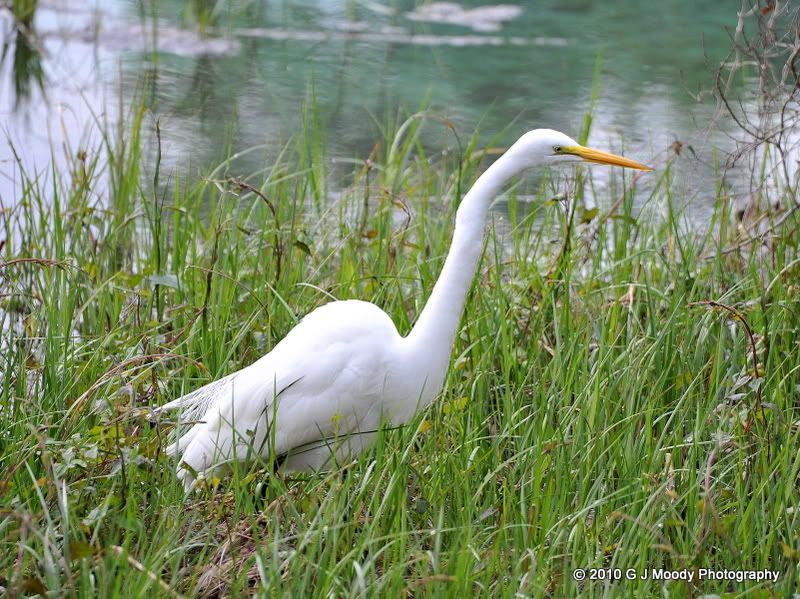Watchin
New Member
 "Watchin the world go bye, trying to grasp the picture."
"Watchin the world go bye, trying to grasp the picture."
Posts: 48
|
Post by Watchin on Mar 25, 2010 15:47:59 GMT -5
Well I put in a black bird for C&C, so now I'm putting in a white one. I feel the highlights are blown out on this and I'd like some advice on how to avoid it.  I tried all my "photo of the bride in noon day sun" tricks, with the exception of a fill flash, and I'm still not happy. Any ideas on what I'm not doing or doing wrong? |
|
|
|
Post by Robert Strickland on Mar 25, 2010 18:14:45 GMT -5
Treat It like snow and and compensate one to two stops. Normal 1 1/2 stop will keep some detail. Or take a reading on a neutral subject, place that reading in manual and take the white Egret. Very Nice Shots
|
|
Watchin
New Member
 "Watchin the world go bye, trying to grasp the picture."
"Watchin the world go bye, trying to grasp the picture."
Posts: 48
|
Post by Watchin on Mar 25, 2010 23:15:23 GMT -5
Thanks Robert. I only compensated 1 stop, so that may solve it. I'll have to experiment with a wider range. I have always resisted going too far because you loose shadow detail (like on a brides face), but
thinking about it that shouldn't be a problem with an all white bird... duh.
Do you use spot meter or general average metering? This was spot metered on the head, then comped a stop.
|
|
|
|
Post by Maureen on Mar 26, 2010 0:52:51 GMT -5
If you spot meter, try metering off the bird's back. They have skinny little heads and it's hard not to include the eye, the bill or the water.
If your bird wasn't being a statue, you might consider matrix metering and comping -1.
You'll lose some shadow detail, but the bird will look good...
|
|
|
|
Post by FLCracker on Mar 26, 2010 9:39:48 GMT -5
All of the metering tricks will help. I'd also suggest getting down on the same level as the bird if possible. The blowouts on white wading birds happen on the back and the top of the head. A lower camera angle minimizes that area and shows more of the side of the bird without the glare. A polarizer will also help at the loss of a couple of stops. You can overexpose 1.5 stops and lose 2 for the polarizer and you are almost back where you started from.
|
|
Watchin
New Member
 "Watchin the world go bye, trying to grasp the picture."
"Watchin the world go bye, trying to grasp the picture."
Posts: 48
|
Post by Watchin on Mar 27, 2010 15:50:27 GMT -5
Hmmm, getting lower wouldn't work this time, but I'll try that; polarizer would be a good experiment as well; Thanks Ron.
Spot meter on the body, seems obvious in hindsight ( 1 self-administered dope slap). Since it was hunting I should have tried the matrix trick, another good idea.
Now I've got a bunch of experiments to do.... where do I find the time?
|
|
|
|
Post by FLCracker on Mar 27, 2010 18:02:24 GMT -5
With all of these hints it was left unsaid that it's still a nice shot. You got the habitat and the behavior and the composition is good.
Do you shoot RAW or JPEGs? If you shoot RAW you can get back some detail in the hottest whites by using the levels adjustment, if JPEGs then you are more restricted but you might still be able to darken the highlights somewhat.
The question is where do you find time for everything else after you've gone out shooting.
|
|
Watchin
New Member
 "Watchin the world go bye, trying to grasp the picture."
"Watchin the world go bye, trying to grasp the picture."
Posts: 48
|
Post by Watchin on Mar 28, 2010 9:48:06 GMT -5
For right now I'm shooting JPG due to space. While I'm experimenting I shoot a lot of shots with different settings. Once I've developed a technique I'll switch to RAW. I also find that JPG forces me to try to get it perfect the first time instead of being lazy and relying on "I'll fix it in photoshop". Doesn't always work, but I try...  |
|